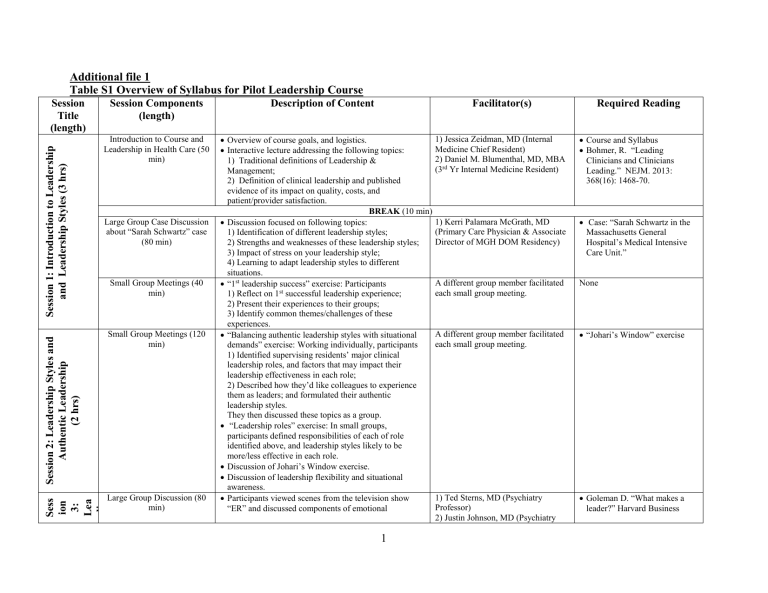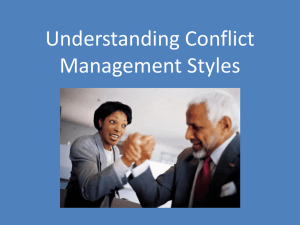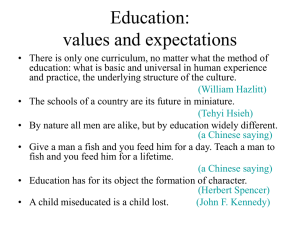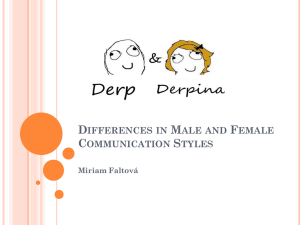file - BioMed Central

Additional file 1
Table S1 Overview of Syllabus for Pilot Leadership Course
Session
Title
(length)
Session Components
(length)
Description of Content
Introduction to Course and
Leadership in Health Care (50 min)
Large Group Case Discussion about “Sarah Schwartz” case
(80 min)
Small Group Meetings (40 min)
Small Group Meetings (120 min)
Large Group Discussion (80 min)
Facilitator(s)
Overview of course goals, and logistics.
Interactive lecture addressing the following topics:
1) Traditional definitions of Leadership &
Management;
2) Definition of clinical leadership and published
1) Jessica Zeidman, MD (Internal
Medicine Chief Resident)
2) Daniel M. Blumenthal, MD, MBA
(3 rd Yr Internal Medicine Resident) evidence of its impact on quality, costs, and patient/provider satisfaction.
Discussion focused on following topics:
BREAK (10 min)
1) Kerri Palamara McGrath, MD
1) Identification of different leadership styles; (Primary Care Physician & Associate
2) Strengths and weaknesses of these leadership styles; Director of MGH DOM Residency)
3) Impact of stress on your leadership style;
4) Learning to adapt leadership styles to different situations.
“1 st leadership success” exercise: Participants
1) Reflect on 1 st successful leadership experience;
2) Present their experiences to their groups;
3) Identify common themes/challenges of these experiences.
“Balancing authentic leadership styles with situational demands” exercise: Working individually, participants
1) Identified supervising residents’ major clinical leadership roles, and factors that may impact their
A different group member facilitated each small group meeting.
A different group member facilitated each small group meeting. leadership effectiveness in each role;
2) Described how they’d like colleagues to experience them as leaders; and formulated their authentic leadership styles.
They then discussed these topics as a group.
“Leadership roles” exercise: In small groups, participants defined responsibilities of each of role identified above, and leadership styles likely to be more/less effective in each role.
Discussion of Johari’s Window exercise.
Discussion of leadership flexibility and situational
awareness.
Participants viewed scenes from the television show
“ER” and discussed components of emotional
1) Ted Sterns, MD (Psychiatry
Professor)
2) Justin Johnson, MD (Psychiatry
1
Required Reading
Course and Syllabus
Bohmer, R. “Leading
Clinicians and Clinicians
Leading.” NEJM. 2013:
368(16): 1468-70.
Case: “Sarah Schwartz in the
Massachusetts General
Hospital’s Medical Intensive
Care Unit.”
None
“Johari’s Window” exercise
Goleman D. “What makes a leader?” Harvard Business
Small Group Meetings (40 min)
Large Group Discussion (50 min) intelligence exhibited in each scene. Chief Resident)
BREAK (10 min)
Role playing activity
Individual reflection and large group discussion about role playing activity.
Drs. Sterns and Johnson
Drs. Sterns and Johnson
Large Group Case Discussion about “A Day on the
Bigelow” case (80 min)
Large Group Case Discussion about “A Day on the ID ISR” case (60 min)
Small Group Meetings (30 min)
Discussion focused on identification of common challenges of leading a clinical team and strategies for addressing these challenges.
1) Katrina Armstrong, MD
(Oncologist & Chief of MGH DOM)
2) Daniel Hunt, MD (Clinicianeducator & Chief, Hospital Medicine
Unit)
Discussion focused on following topics:
BREAK (10 min)
1) Alberto Puig, MD, PhD (Clinician-
1) Managing relationships with superiors and non-MD clinicians; and educator & Associate Professor of
Medicine)
2) Approaches for addressing interdisciplinary conflict.
Participants completed post-course evaluations. None
Review. 1998: 92–102.
None
None
Case: “A Day on the Bigelow”
Case “A Day on the Infectious
Disease (ID) Inpatient
Subspecialty Rotation (ISR)”
None
Table S2: Course Strengths
General
Topic
Preparatory
Work
Specific Strength
Case studies
Supplemental Reading
Number of
Comments
3
2
Large
Group
Meetings
Small Group
Meetings
Moderators
Content of Discussions
Psychologically Safe
Environment
Agendas and exercises
Extended Evening Small
Group Session
Course Timing
5
5
4
3
1
1
Specific Examples
“Well thought out written cases for large group discussions.”
“Focused but very high yield supplemental readings about leadership styles, emotional intelligence, leadership and management tips.”
“Some specific strengths were prepared facilitators who were well respected physicians who are themselves considered leaders.”
“Case discussions were terrific.”
“Provided an arena to discuss with peers concerns and hesitations about leadership”
“Small group interactions that helped allow for peer-based learning.”
Course Facilitates Development of
Practical Skills
Course Provides protected time and safe forum for reflection and discussion
The course overall (i.e. just having
Specific Course
Content it)
Leadership
Styles
Authentic
Leadership
Emotional
Intelligence
4
4
2
2
1
1
“Timing is perfect, right before we embark on junior year.”
“Practically addressed and anticipated issues we will face as junior residents.”
“The small group sessions allowed very honest discussions with our classmates about the fears and leadership challenges we anticipate throughout the course.”
“Having this course in the first place is a great strength.”
“A focus on leadership qualities/characteristics/styles with recognition of the differences.”
“Facilitated my understanding of my authentic leadership style and enabled me to reflect on situations where I am forced out of my authentic style and into other styles.”
Table S3: Course Weaknesses and Suggestions for Improvement
General
Topic
Specific Weakness Number of
Comments
Examples of Feedback
Course
Materials
Course workload
Large Group
Meetings
Small Group
Meetings
Course
Organization and Logistics
Syllabus unclear
Instructions for one or more exercises unclear
Amount of preparatory work is at upper limit of what is reasonable (w/o causing fatigue)
Content and/or Structure of “Leading with Emotional
Intelligence” Session (i.e. role playing, use of television show clips).
Content and/or structure of
“Leading Clinical Teams”
Session
Redundancy in content addressed by different facilitators
Conversations often strayed off topic
Ineffective achieving objectives
Remove Evening Session
Course takes away from other learning opportunities
1
2
1
7
2
2
3
5
2
1
“My group floundered for quite some time trying to figure out exactly what we were supposed to do.”
“I would not add more cases or reading or I think you would cause case fatigue during ACR.”
“The emotional intelligence session provided a great platform to discuss the topic, but the lecture, videos, and role playing was quite redundant.”
“Coordinate more among speakers, so they know what topics have been covered to avoid unnecessary redundancy.”
“Conversations easily fell off topic. Exercises were not as helpful in focusing discussion as needed.”
“I feel that the small group discussions were not as helpful as the larger case discussions.”
“Do not have an evening meeting.”
“I didn't like that it took away from ACR
[outpatient] lectures.”
Course
Learning
Methods
Course should be multidisciplinary
Incorporate activities (e.g. simulation, role plays) to practice skills learned in course
Incorporate use of available personality inventories to facilitate self-awareness
Course should be expanded beyond one month
1
2
2
1
“One way in which this the course could move forward is by incorporating fellows and/or residents from other departments, as well as members of nursing staff, to be involved in the leadership discussion to get in-person feedback on what they view as effective leadership depending on the context and situation.”
“It would be nice if we could get some leadership/personality inventories so that we could learn more about our own leadership styles.”
“Expand beyond one month.”







